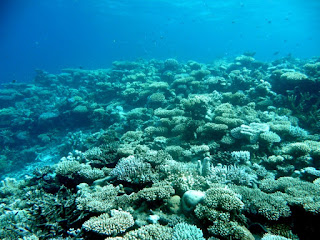In the past blog posts we have looked at changes to the corals in the Red Sea and the Barrier Reef, but now it is time to go down in scale, and take a look at something much smaller. Zooxanthallae, as mentioned in previous posts, are photosynthetic bacteria that allows corals to feed. We will take a closer look at the relationship between the two, and how changing environments is resulting in bleaching.
 |
| An enlarged view of the microscopic Zooxanthallae. |
The relationship between coral and zooxanthallae is mutually beneficial. The coral provides a safe environment for the zooxanthallae. The bacteria can then produce oxygen and glucose whilst removing waste (this is photosynthesis). This allows the coral to feed and can remain sessile. This is a very important relationship as otherwise the coral would struggle to feed itself, as they cannot photosynthesise themselves. From a more commercial viewpoint, the bacteria is important as it is the zooxanthallae itself that provides the colour for the coral. The bright vibrant colours attract various marine life such as fish, which in turn attracts tourists to destinations all over the world. Thus the relationship helps to bring in an estimated $9.6 Billion per year through coral reef generated tourism. As the bacteria requires sunlight, corals need to exist in shallow, clear oceans. However due to anthropogenic activity, the pristine environment which allows this relationship to flourish is being put under incredible strain.
Corals and zooxanthallae are being put under extreme pressure by rising temperatures. Higher temperatures will result in the bacteria being expelled from the coral. As they bacteria determines the colour of the coral, the coral will become white. This also means that the coral has no way to obtain food. They are not dead however. They can remain almost in a state of hibernation for some time. This gives the conditions a chance to return to acceptable levels. If this happens then the bacteria will return to the coral and the relationship will be back on track. However too long without being able to
feed will result in the death of the coral.
The threshold at which the bacteria will leave the coral depends on different types of coral and zooxanthallae. Exposure to high temperatures (32 degrees and above) for as little as 7 hours can result in expulsion of zooxanthallae at 1000 times the normal rate. This shows just how sensitive the corals and bacteria can be, especially to storm events, where there are isolated incidents of rapid
heating. For example there was mass expulsion of zooxanthallae in Jamaica after Hurricane Flora. Having said this, the corals examined in the study returned to normal after 17 days, so there is some hope for corals, as they are resilient.
Coral and zooxanthallae have evolved together so they are almost thought of as one. Bleaching remains a serious threat to the coral, and they could be completely destroyed as a result of it. So much would be lost if this were to come to fruition, and the worlds oceans may never be able to recover.
Sources
1. https://themarketmogul.com/the-economic-impact-of-coral-reefs/
2.http://www.sciencedirect.com/science/article/pii/0022098189901093





